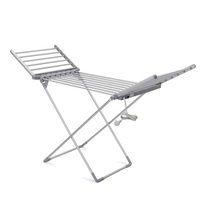5 tips on how to dry clothes indoors without a clothes dryer
Expert tips to save energy

As the temperature plummets and we face more rainy days, it can be a challenge to dry clothes outside. Laundry takes longer to dry, and even when it’s been hanging out all day, it can still feel damp and smell musky.
But drying clothes indoors can be just as challenging. Space is an obvious issue, but extra moisture and humidity are two factors that encourage mold and mildew growth in your home. You may also notice an increase in condensation inside your windows caused by insufficient ventilation.
The easiest option is to dry your clothes indoors using one of the best clothes dryers, but with high energy costs, you may be reluctant to switch it on, even if you have an energy efficient appliance which is Energy Star certified. Here we’ve gathered 5 top tips on how to dry your clothes indoors while keeping on top of your energy bill.
1. Invest in a dehumidifer
When drying clothes indoors, the excessive moisture has to go somewhere, and it can result in condensation when it’s too chilly to keep your windows open wide. However, the problem can be overcome using one of the best dehumidifiers that removes excess moisture from the air. It will reduce the knock-on issue of mold growing in your home, which loves damp surfaces.
We recommend this Midea dehumidifier as the best budget appliance. It has a 20-pint water capacity, the controls are user-friendly, and it’s compact to store. It’s also super easy to empty and performed well during testing, which is why we recommend it as the best budget dehumidifier.
2. Go for a spin

It’s not rocket science, but putting your wet laundry on an extra spin will help remove more moisture. An additional 10 minutes in the washing machine will speed up drying time and ensure your heavier items, such as jeans and towels, aren’t hanging around in your home for days.
3. Plug in a heated airer
Most of us have a clothes airer to hand when it’s too cold or wet outside to dry laundry. However, clothes take longer to dry during the colder months, so it’s worth considering a heated clothes airer. Although they need to be plugged in, they require far less energy than a clothes dryer.
Smol says, “Heated airers can dry a light load of delicates in anything from 1 to 3 hours, but if you’re drying a heavy load of towels, wooly jumpers or jeans, it could take up to 10 hours.”
Sign up to get the BEST of Tom's Guide direct to your inbox.
Get instant access to breaking news, the hottest reviews, great deals and helpful tips.
Although purchasing a heated dryer will cost you more than a standard model, it’s best to look for a version with a low wattage that still provides sufficient heat, and for one that you can set to turn off after a set period — this prevents the problem of wasting energy by forgetting to switch it off. Some also come with additional covers that help to retain heat and speed up the drying time.
This collapsible heated clothes drying rack extends to 57.8 inches, with a height of 37 inches and folds up compactly when not in use. It includes 20 heated drying rods to speed up drying wet clothes, plus the aluminum frame is sturdy and rust-resistant.
4. Place your clothes airer in a well-ventilated spot

Ensure you place your clothes airer in a well-ventilated spot. Placing it close to a wall may trap moisture, potentially leading to mold issues. For better air circulation, position it near a slightly open window, a fan or an air conditioner vent, if you have one. I often place my clothes airer near a sunny south-facing window to make the most of the natural warmth, rather than in a cold room.
5. Hang your clothes up efficiently
How you load your clothes airer can greatly impact the drying time. Space your clothes out evenly and leave enough room for air to circulate, which will help your clothes dry faster. Another tip is to use hangers or clothespins to allow your clothes to dry vertically rather than being folded over a rack. A bonus is that they’ll require less ironing.
More from Tom's Guide

Camilla Sharman has worked in publishing and marketing for over 30 years and has covered a wide range of sectors within the business and consumer industries both as a feature, content, and freelance writer.
As a business journalist, Camilla has researched articles for many different sectors from the jewellery industry to finance and tech, charities, and the arts. Whatever she’s covered, she enjoys delving deep and learning the ins and out of different topics, then conveying her research within engaging content that informs the reader. In her spare time, when she’s not in her kitchen experimenting with a new recipe, you’ll find her keeping fit at the gym. In the pool, stretching at a yoga class, or on a spin bike, exercise is her escape time. She also loves the great outdoors and if she’s not pottering about in her garden, she’ll be jumping on her bike for a gentle cycle ride.


